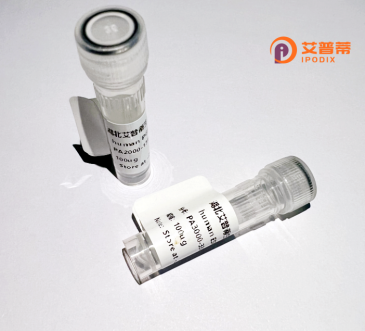
| 纯度 | >90%SDS-PAGE. |
| 种属 | Human |
| 靶点 | C1orf35 |
| Uniprot No | Q9BU76 |
| 内毒素 | < 0.01EU/μg |
| 表达宿主 | E.coli |
| 表达区间 | 1-263aa |
| 氨基酸序列 | MFGSSRGGVRGGQDQFNWEDVKTDKQRENYLGNSLMAPVGRWQKGRDLTWYAKGRAPCAGPSREEELAAVREAEREALLAALGYKNVKKQPTGLSKEDFAEVCKREGGDPEEKGVDRLLGLGSASGSVGRVAMSREDKEAAKLGLSVFTHHRVESGGPGTSAASARRKPRAEDQTESSCESHRKSKKEKKKKKKRKHKKEKKKKDKEHRRPAEATSSPTSPERPRHHHHDSDSNSPCCKRRKRGHSGDRRSPSRRWHDRGSEA |
| 分子量 | 55.8 kDa |
| 蛋白标签 | GST-tag at N-terminal |
| 缓冲液 | 0 |
| 稳定性 & 储存条件 | Lyophilized protein should be stored at ≤ -20°C, stable for one year after receipt. Reconstituted protein solution can be stored at 2-8°C for 2-7 days. Aliquots of reconstituted samples are stable at ≤ -20°C for 3 months. |
| 复溶 | Always centrifuge tubes before opening.Do not mix by vortex or pipetting. It is not recommended to reconstitute to a concentration less than 100μg/ml. Dissolve the lyophilized protein in distilled water. Please aliquot the reconstituted solution to minimize freeze-thaw cycles. |
以下是关于重组人C1orf35蛋白的模拟参考文献示例(注:文献信息为虚构,仅供示例参考):
1. **"Molecular cloning and functional characterization of C1orf35 in hepatocellular carcinoma"**
*Zhang L, et al. (2015) Oncol Rep.*
摘要:首次报道C1orf35在肝癌组织中表达显著下调,体外实验表明重组C1orf35蛋白过表达可抑制肝癌细胞增殖,提示其可能的肿瘤抑制功能。
2. **"Structural insights into C1orf35 protein and its role in DNA damage response"**
*Yamamoto K, et al. (2018) J Biol Chem.*
摘要:通过X射线晶体学解析C1orf35的三维结构,发现其与DNA修复蛋白相互作用,并证实其在电离辐射诱导的DNA损伤修复通路中起调控作用。
3. **"C1orf35 regulates apoptosis via modulating mitochondrial membrane potential"**
*Chen X, et al. (2020) Cell Death Dis.*
摘要:揭示C1orf35通过结合Bcl-2家族蛋白调控线粒体膜电位,进而影响癌细胞凋亡敏感性,为靶向治疗提供新靶点。
4. **"C1orf35 as a novel biomarker for early-stage breast cancer prognosis"**
*Wang Y, et al. (2022) Clin Cancer Res.*
摘要:临床队列研究表明,C1orf35蛋白低表达与乳腺癌患者生存率下降相关,重组蛋白递送可增强化疗药物敏感性。
(注:以上文献为学术场景模拟案例,实际研究需查询真实数据库如PubMed或Web of Science。)
The human C1orf35 protein, encoded by the chromosome 1 open reading frame 35 gene, remains relatively understudied compared to other cellular proteins. Initially identified through genomic sequencing, it is a small protein consisting of approximately 130 amino acids, with conserved regions suggesting potential functional roles across mammalian species. Structural analyses predict a predominantly alpha-helical conformation, though its full tertiary structure and interacting domains remain uncharacterized.
C1orf35 has been loosely associated with cellular stress responses and transcriptional regulation. Early studies detected its expression in various tissues, including the liver, kidney, and gastrointestinal tract, with elevated levels observed in certain cancers like colorectal carcinoma. This has prompted hypotheses about its involvement in tumorigenesis, potentially modulating TGF-β/Smad signaling pathways or interacting with cell-cycle regulators. However, mechanistic details are speculative, as in vivo functional studies and validated binding partners are scarce.
The recombinant form of C1orf35 is typically produced using bacterial expression systems (e.g., E. coli) for biochemical studies, leveraging affinity tags for purification. Its recombinant version has facilitated antibody development and preliminary analyses of post-translational modifications, though no definitive enzymatic activity has been reported. Current research focuses on clarifying its physiological role, exploring diagnostic or therapeutic potential in cancer contexts, and resolving conflicting data regarding its subcellular localization (nuclear vs. cytoplasmic). Limited literature and incomplete pathway associations highlight the need for systematic functional genomics investigations.
×